Technologies, prospects and hopes of RadioAstron

The center of the Milky Way galaxy in a Spizer infrared space telescope. © NASA
We continue the conversation with the head of the laboratory of extragalactic radio astronomy of the PN Lebedev Physical Institute of the Russian Academy of Sciences Yuri Kovalev. Today we are talking about data processing technologies that allow us to obtain unique knowledge about interstellar and intergalactic space, the Nobel potential, about relations with China, and the prospects of domestic radio astronomy.
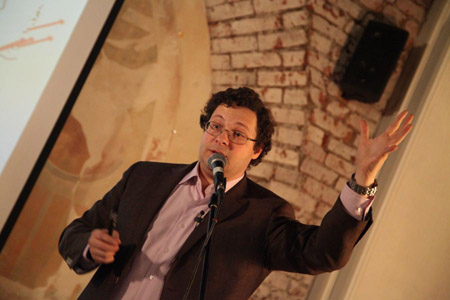
© polit.ru
The RadioAstron project is a radio astronomy experiment based on the method of radiointerferometry with super-long bases (VLBI). The essence of this method is that two or more radio telescopes work as elements of a single large antenna. This allows observations with a very high (record) angular resolution, which depends on how far the telescopes are spaced apart. With ground-based observations, it is impossible to increase the size of the VLBI network above the diameter of planet Earth. You can increase the resolution by putting one of the telescopes into space. The 10-meter Russian “Spectr-R” became such a telescope. The limitation of this method is that only bright sources of radio emission can be observed: quasars, pulsars, etc. The distance between the Earth and the spacecraft is called the “base projection” and is considered to be in diameters of the Earth. The larger the projection, the higher the resolution.
')
In the first part of the interview we talked about the results achieved. Today we are talking about the future.
- I think many will be interested in the question: is there any direction in the RadioAstron program that has the potential for the Nobel Prize?
- The question is good and correct. The problem is that the answer to it more characterizes the responder than the project itself. Therefore, it is somewhat difficult for me. But why don’t we try to be careful on the one hand, so as not to be accused of being too “pop”, and on the other hand, close to the topic. Attempts to map the center of our galaxy and restore its true image, this is an obvious potential for the Nobel Prize. If we succeed ... If at least once the Nobel Prize is given for the most direct or least indirect discovery of a black hole ... the so-called "shadow of a black hole" - such a circle or crescent at a distance of several horizons of black hole events - I predict that to do it without the effect of the substructure of the spot of dispersion that we discovered is simply impossible. Therefore, whether or not the Nobel Prize will be awarded for RadioAstronom, our contribution to the Nobel Prize on this issue should be included. And it is already included in the sense that all the publications of the last 1-2 years on this topic necessarily discuss this effect, take into account, analyze.
If we talk about the award for us, then we conducted the corresponding experiment in September 2015. The mapping of the center of our Galaxy at a wavelength of 1.3 centimeters was carried out using a space radio telescope and about twenty antennas on Earth - American, Australian, Korean, Chinese. If we succeed in carrying out the restoration of the true image of the center of the Galaxy, to obtain information about the shadow of a black hole, then this is obviously the potential for a Nobel Prize.

Simulation of various options for the image of a black hole.
- That is, in fact, you can see a black hole? At least the fact that it can be seen at all.
- Yes, this is what Nikolai Kardashev, project manager, said before the launch. I was more conservative in predictions ... Mostly, I tried to estimate the minimum "guaranteed" list of results that RadioAstron is able to give. Nikolai Semenovich always looks at problems widely and, quite often, with his genius, I’m not afraid of this word, can predict things that seem too bold to many others. He said before launching the Spectra-R into space that RadioAstron would see black holes.
We tried to do this by observing the center of the galaxy in the constellation Virgo (Virgo A or M 87). Technically, we have this possibility with the existing orbit and operating receiver at the shortest wavelength of 1.3 cm. We should have been lucky in the sense that the conditions for absorption (sometimes called synchrotron self-absorption) and the scattering of radiation should have been soft enough to see the shadow of a black hole. Failed. It is possible that due to synchrotron self-absorption. It is clear where to go - on shorter waves, on which these effects are weaker.
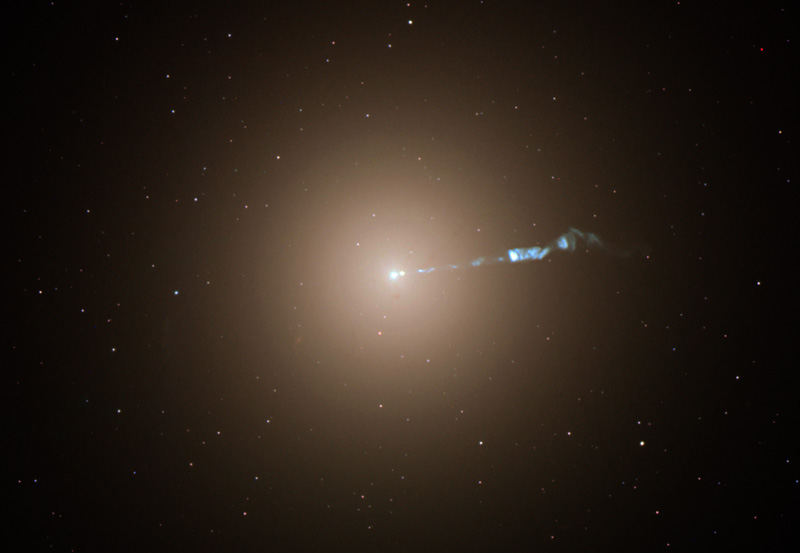
M 87 in the Hubble space telescope. Clearly visible relativistic jet from the center of the galaxy (c) NASA
In the center of the galaxy were not going to work, because they knew about the dispersion on dense clouds. Our discovery of the effect of the scattering substructure gave hope to restore the true image of the center of the Galaxy by taking this effect into account. Maybe we will succeed. This will be a result close to the level of the Nobel Prize ... Again, to be optimistic, if we are lucky. We are working in this direction, the first results are positive, insanely interesting and already a large number of articles on this topic have been published. In any case, RadioAstron has significantly advanced world science in this direction, even if the prize will not be given to us.
(Links: one , two , three , four , five . All publications on the RadioAstron project: here ).
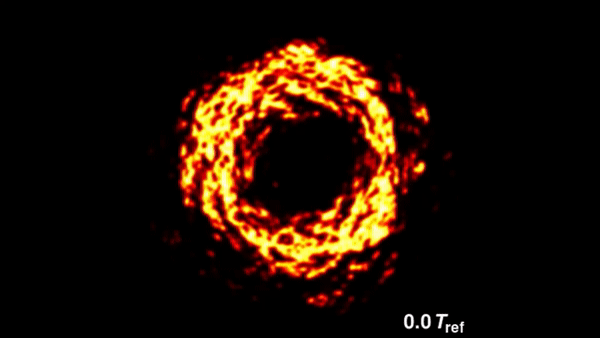
Simulating the variability of the refractive scattering substructure for the ring to understand what to expect for the “black hole shadow”. The apparent movement is associated with the movement of a turbulent cloud in front of the ring. (c) Michael Johnson (Harvard CfA).
As for other areas, it is more difficult to predict. There are a lot of interesting results on quasars, but as far as they have the potential for the Nobel Prize, it is quite difficult for me to judge, I will be accurate here.
- Do you think the data of RadioAstron, the results of its work will somehow have a significant adjustment or impact on the change in the modern cosmological picture of the Universe?
- If to be realistic, it is unlikely. Cosmological tasks did not face the RadioAstron project. Probably the only direction that could potentially contribute to the understanding of dark energy is the study of megamasers [ star formation clouds in other galaxies ] due to the possibility of an independent estimate of the distances to them.
- Let's go back to Earth. You mentioned the participation of Chinese scientists in the project. They built a new telescope. Is it planned to be involved in the RadioAstron program?
- Undoubtedly, when it begins to work in the mode of interferometry with super-long bases (VLBI), it can become an element of the ground-space interferometer, and we will definitely use it in the RadioAstron project. I have absolutely no doubt. We work with all the largest radio telescopes in the world that conduct experiments on VLBI astrophysics. RadioAstron does not impose any special requirements on ground-based telescopes to work in its fashion. Moreover, speaking of China, we have a memorandum of understanding between the FIAN Astro-cosmic Center and the Shanghai Observatory. Obviously, it will be honorable politically and scientifically interesting for any radio telescope to participate in the observation with RadioAstronomer. There have never been projects of this class in centimeter and decimeter space radio astronomy and, unfortunately, are not expected in the near future. For example, it was our success that led to the fact that the Chinese project of the ground-space interferometer, unfortunately, did not happen - this is my reading of the situation. The Chinese space agency did not support him. We are the only chance for ground-based telescopes to participate in such experiments in the coming years. And I hope that the FAST telescope - the 500-meter telescope - will introduce the interferometric mode of observations as soon as possible in order to work with RadioAstron. There are quite a few examples of telescopes that started working with us while being just built and launched. For example, a 65-meter telescope with an active surface near Shanghai, a 64-meter telescope with an active surface in Sardinia. Immediately after the return to service, the 32-m telescope in Irbene, restored by Latvian colleagues, began working with us.
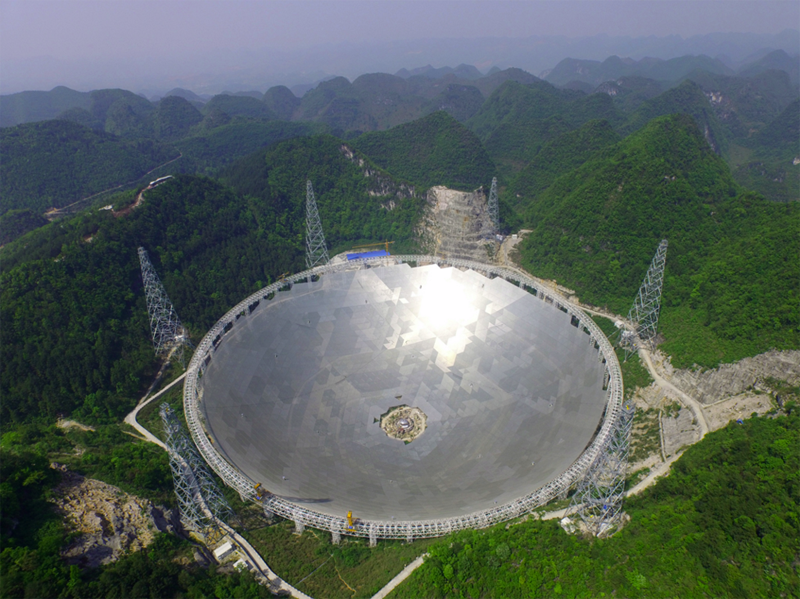
Radio Telescope FAST (China) (c) Fast.bao.ac.cn
- Do the dimensions and capabilities of Chinese FAST promise an increase in the quality of observations?
- Of course they promise. Here is such a beautiful situation: the sensitivity of the interferometer is equal to the root of the product of the sensitivities of the two telescopes that form it. In space, you cannot launch a 500 meter plate, in space, you cannot cool amplifiers to very low temperatures for many years ... Either you cool for a short time, or you send “warm” receivers. We have a 10-meter space telescope, this is the largest telescope in space, we even have a certificate of the Guinness Book of Records. RadioAstron receivers are cooled passively. If you have a larger telescope on Earth, then it gives you the opportunity to improve the sensitivity of the interferometer as a whole. Today, the largest telescope that works with ours is the 300-meter analogue of FAST, the Arecibo antenna in Puerto Rico, USA. Arecibo understands how perfectly we complement each other, so observations with the RadioAstron for the Arecibo telescope are among the top priorities. We are able to explore weaker cosmic signals, more objects that are farther away, as well as more subtle effects, including the effect of the scattering spot substructure and much more.
- I think many will be interested in where and how the data received by RadioAstron is processed. What capacities?
- Yes, let's talk about it. When processing occurs the following. Suppose we are conducting a typical RadioAstron experiment. Usually, from 3 to 30 radio telescopes operate on the Earth, as well as the Spectr-R space telescope. At the same time, observations are made up to hydrogen frequency standards. [The hydrogen standard frequency is an ultra-precise atomic clock - approx. ] Accordingly, ground-based telescopes record data on-site. The space dumps in real time to Earth via tracking and gathering stations in Pushchino (Moscow region) and Green Bank (West Virginia, USA). Then this data is brought to the center of correlation in the usual electronic way, that is, transmitted via the Internet. Dedicated channels, in fact.
The first processing step is the so-called “correlation processing”. It is conducted on one of the three correlators. These are computer clusters with a hundred or two cores. They are used to correlate all the data streams recorded from each telescope with each other. As a result, if it is very simplistic, at the output we get the value of the correlation coefficient depending on the time between each pair of telescopes.

Photo of the part of the cluster used to correlate RadioAstron data in the ASC LPI. (c) ASC LPI
The second step is already “post-correlation processing”, when we remove and correct all the effects that the measuring system has introduced into the data — the interferometer, and the Earth’s atmosphere. We compensate for the phase delay of the signal on each telescope. The phase also deteriorates as it passes through the atmosphere, the ionosphere, the Earth's troposphere ... An imperfect clock on each telescope, delays in electronics. This is perfectly normal, there is no problem, this is a real experiment. Something perfect happens only on paper, but in life you need to calibrate all these effects. We translate the amplitude from the internal units of the electronics used to the physical units. At the output we get a complex signal with already corrected, or, correctly said, calibrated amplitude and phase. This is the second processing step.
Next is the analysis of the data, depending on what we conducted the experiment. There are very different types of analysis. If you build a quasar image, then this is the so-called “hybrid mapping”. From the data set we restore the image of the object. Spectral analysis can be carried out if you are engaged in spectroscopy, study maser, respectively, you are looking for a spectral line in the data. You are engaged in pulsars - you need to separate the pulses from the entire data stream. This is the last step. Let's call the "post-correlation analysis."
Now where are they held. As I said, the first step - the correlation - is carried out on three correlators. Odin is located in Moscow at the Astronomical Center of FIAN. This is the main correlator of the RadioAstron project. It processes about 85% of the data. The remaining about 15% are correlated in Bonn, at the Max-Planck Institute for Radio Astronomy, and at the Joint Institute for VLBI in Europe, the Netherlands. These three correlators are different, iron, correlation programs are different. One of our pride is that the outputs of these correlators coincide. If you process the same experimental data on these three supercomputers, the result will coincide up to errors. It's great. Naturally, it was incredibly important during the first year to make sure that we all agree with each other and an independent analysis of the data, giving the same thing - is it not happiness? .. That, you know, how the debtors and debts converge with the financiers.
Post-correlation processing and analysis are carried out by the project's scientific groups, which include co-authors from approximately twenty countries of the world. Some of their tasks require supercomputers, some rather powerful workstations, and some on a laptop can be done.
- What do you think, how long will RadioAstron be able to work?
- A private question, if I were a politician, said “The Russian Space Agency, based on the decision of the state commission, extended the RadioAstron project until the end of 2018”. True truth. The decision was made in the spring of 2016. With regard to technical capabilities ... Yes, we see the degradation of equipment on board. However, we and NPO Lavochkina all systems are duplicated or built. Some have remained in one or two copies today. From the very beginning of the launch of the space project into space we live with the understanding that today may be our last day, or maybe we will live many more years.

"Spectr-R" in the assembly shop (c) NPO Lavochkina
- About the degradation here. We can say that children's diseases have passed, and everything is now working normally?
- This we could say in the first year of flight. Children's diseases were, and on Earth, and in space. I can tell you the date when we ended up with the last serious childhood illness. March 15, 2012. From the moment we are working in normal mode in all modes. Four wavelength ranges, full intensity and polarization, masers, pulsars, quasars are all different modes. Multi-frequency mode in a wide range from 18 to 25 GHz.
Working in a regular mode, we have that some equipment fails. NPO Lavochkina either switches to backup systems or solves the problem. To date, the characteristics of the Spektr-R apparatus and its ability to solve scientific problems are approximately at the same level as in the spring of 2012, when we entered a full-fledged battle mode. We have certain new restrictions. For example, the situation with gyrodynes . But nothing up to this day has not significantly affected the ability to continue the implementation of the scientific program, which is formed every year on the basis of an open call for proposals.
- Quite a pop question: Can we find aliens with the help of RadioAstron?
- Aliens can be found, as you know, with the help of glasses, if they disembark near your house and enter your apartment. Accordingly, we can. For example, if we see the “cosmic miracle”, which cannot be explained by any modern laws of physics.
- If we observed the Earth with the help of RadioAstron from any distance, could we determine its certain anomalous behavior? Including in the radio. If they could, from what distance?
- I don’t think you need RadioAstron for this, since the Earth is very small and in any case would look like a dot. In this sense, you need a very large and, accordingly, sensitive telescope, such as the FAST. He is one of the prototypes of Square Kilometer Array (a telescope project with a collecting surface of a square kilometer). SKA is currently under construction in the southern hemisphere, part in Africa, part in Australia. In fact, if you build a huge very highly sensitive telescope, you can register the emission of organic molecules from distant planets. Accordingly, life, though not reasonable. This task faces many ground-based telescopes. The same cosmic Millimetron we are developing will have the necessary angular resolution to see the shadow of the black hole, will work at high frequencies to overcome the absorption problem. And on the third hand, it will have high sensitivity and work at radio frequencies, which will allow to investigate the emission of organic molecules.
- My question was not how much radiation of organic matter, how much our economic activity. For example, radar and the like.
- The “Spectrum-R” itself - a 10-meter mirror in space - is difficult to solve this task with the sensitivity of ground-based telescopes. As for interferometry ... Suppose we have found some suspicious candidate that you need to investigate with extreme angular resolution, while the sensitivity of the interferometer is enough. Then RadioAstron can connect and find anomalies. You understand, pop question - partly pop answer. Yes, if we see anomalies, we can discover aliens. So far we have not seen such anomalies in the Universe.
- You started answering a question I had not yet asked about Millimetron and about the prospects for Russian radio astronomy in the coming years. What do you expect to be expected? What work is currently underway for the future?
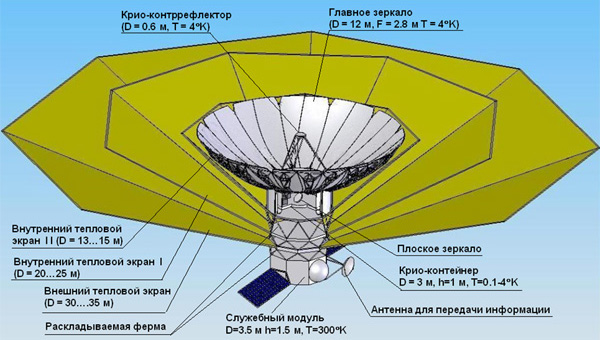
The project of the space radio telescope "Spectrum-M" (Millimetron) (c) ASC LPI
- We are talking only about space or about the Earth too?
-Can and about the Earth, we are talking about science in principle.
-Good. I'll start with the earth. Over the previous year, an interdepartmental working group of experts collected and analyzed proposals for the development of ground-based astronomical infrastructure (telescopes) in the Russian Federation. It was about the construction of new or completed construction started. Discussions were held widely and openly. The group of experts formed recommendations with ratings and transferred them to the relevant executive authorities of Russia. As for radio astronomy, one international project and two Russian ones reached the final. International project - Russia's participation in Square Kilometer Array (SKA). The recommendation was the following: SKA is important, great, participation in this project is the future of our country. At the same time, Russia's participation in SKA was recommended after a positive decision on participation in the European Southern Observatory (ESO). The reason is simple - the number of Russian astronomers who can use the resources of ESO is much larger than those who can use SKA.
Among the Russian projects in the field of radio astronomy, two were noted. The first one is the completion of construction of a 70-meter active surface mirror on the Suffa plateau in Uzbekistan.

Canned radio telescope construction on the Suffa plateau (Uzbekistan). (c) A. Zharkov
The second is the construction of a new type of long-wave digital radio telescope based on the experience of the Pushchino Observatory.
Why were these projects selected along with the modernization of the RATAN-600 in SAO RAS? Now long and short waves have received a serious push forward due to the introduction of digital radio astronomy methods and the development of technologies. And as for short waves, the most serious example of recent breakthroughs is the ALMA interferometer, located in Chile. Long waves - LOFAR in the Netherlands.
Millimetron, in this sense, is a similar step in the development of millimeter and submillimeter astronomy. Millimetron can expand the modern features available thanks to ALMA. The latter observes only in certain frequency ranges due to the partial opacity of the atmosphere. Millimetron, being in space, wins. He can observe in the entire range of millimeters and submillimeters. Its sensitivity will be increased due to the thermal shield and active cooling of the mirror surface.
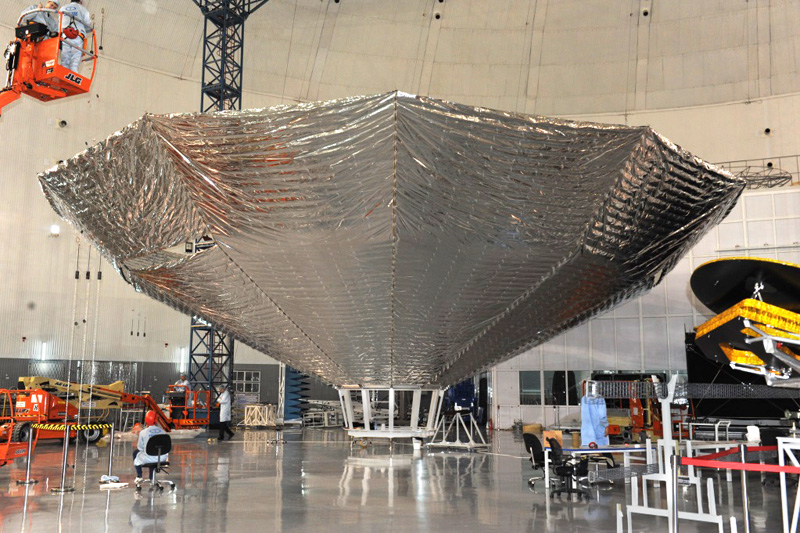
Model of the Millimetron heat shield in the ISS Reshetnev assembly shop (c) ISS Reshetnyova / ORKK
In this case, Millimetron, as a ground-space interferometer, will give absolutely transcendental angular resolution while minimizing the problems of scattering and self-absorption of radiation. This is the next step after RadioAstron.
As for long waves, a lot is known about LOFAR . Russia is lagging behind. We do not participate in LOFAR, but long-wave radio astronomy turns out to be extremely interesting. We - radio astronomers - were able to overcome two problems. One is the problem of the ionosphere and the terrible scattering, in fact, the damage to the phase of the incoming radio emission. On the other hand, horrible noise. New jamming technologies are being actively developed and implemented, allowing us to clean up data from noise automatically, losing about 10% of the data.
We can also mention that, at the suggestion of the Space Research Institute, we are discussing the possibility of building an ultra-long-wave radio telescope on the Moon. If Russia, of course, will go to the moon.
On the significance of the moon for Russian and world radio astronomy, we will continue the conversation in the next issue, stay tuned.
Source: https://habr.com/ru/post/396777/
All Articles